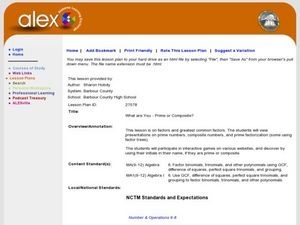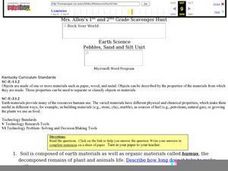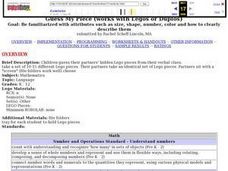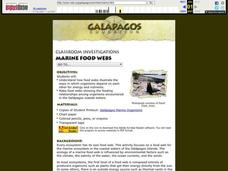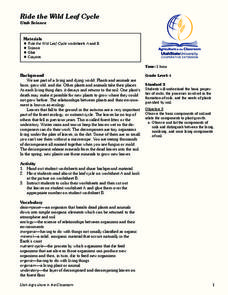Curated OER
What Are You - Prime or Composite
Students explore the concept of prime factorization. In this prime factorization lesson, students participate in an activity where they find the prime factorization and greatest common factor of a number derived from their name. Students...
Curated OER
Cutting Corners
Second graders examine two-dimensional shapes using their characteristics. In this shapes lesson, 2nd graders identify similarities and differences by using cut out shapes, diagrams, mirrors, and graphic organizers.
Curated OER
Following Specs.
Pupils utilyze a set number of DUPLO blocks to build a free-form construction project.
Curated OER
Area Of A Circle
Fifth graders experience a instructional activity to investigate the methods for finding the area of a circle. They use the drawing of segments in order to visualize how a circle can be proposed of many parts. Then students brainstorm in...
Curated OER
Putting It All Together
Students complete activities to learn about the shapes and their vertices. In this shape recognition lesson, students discover the rule linking the number of sides with the number of vertices for shapes. Students categorize...
Curated OER
Too Many Tens
Students practice grouping in different ways by putting numbers up to 1,000 in the correct place value. In this place value lesson plan, students estimate items in a jar and then count them out by grouping them by 10s.
Curated OER
Making Changes
Students observe and record the changes they see when adding heat and cold to objects. In this changes lesson plan, students experiment with different objects and see if heat and cold change the makeup of the object. They then record...
Curated OER
Combining Foods
Students explore addition. For this math lesson, students discover how addition and subtraction are related. Students model related addition and subtraction facts.
Curated OER
Balancing
Students use a balance to complete subtraction problems and weigh out the items they take away. In this subtraction lesson plan, students use a pan balance and record their equations.
Curated OER
Students' Strides
Complete problems using base ten blocks to see the difference in the place value of a decimal and how it affects a number's value. Learners compare decimal values as well. Ample time for discussion and modeling are allowed in the...
Curated OER
Who Eats Whom in the Salt Marsh?
Seventh graders complete a virtual online salt marsh tour. In groups, they observe and identify the various types of animals found in the marsh. After categorizing the animals, they create a food web based on the animals role in the...
Curated OER
Soil Composition
Students examine soil. In this soil composition lesson students participate in soil sedimentation and filtration activities. The students discuss what non-living and living things are in soil and why it is so important.
Curated OER
Autumn
Take a walk through the forest as the leaves change color and fall from the trees, making way for a new ecosystem cycle to cycle through. An inquiry-based lesson plan examines how the process of decomposition eliminates tons of...
Pennsylvania Department of Education
A Geometric Scavenger Hunt
Fifth graders connect their knowledge of polygons and polyhedrons. In this geometric shapes instructional activity, 5th graders identify and classify two- and three-dimensional objects. Students construct a polyhedron out of polygons and...
Curated OER
Money Makes the Fair-Go-Round
Learners explore the value of money. In this money lesson plan, students investigating combining amounts of money and making change. Learners count sets of money and make fair trades. Resources are provided.
Curated OER
Introduction to the Periodic Table of Elements
Learners explain how the elements are arranged in the periodic table. In this chemistry lesson plan, students determine the subatomic particles for certain elements. They research the physical and chemical properties of an element they...
Curated OER
Rock Your World
Young scholars define soil, dirt, clay, silt, and sand. They conduct an online scavenger hunt, answer pre-written online questions on a piece of paper, and play the Earth Materials Game after completing the scavenger hunt.
Curated OER
Numbers Up
Students use Legos to build representations of a variety of numbers. They then sort and order their representations and pair them with the written number.
Curated OER
Guess My Piece -working with Legos
Students participate in guessing their partners' hidden Lego pieces from their verbal clues. They work in partners to accomplish their goals. They are meeting a variety of math standards by completing this instructional activity.
Curated OER
How Many Ways?
Second graders develop number sense. In this number sense lesson, 2nd graders use multiple ways to represent numbers including written numerals, tally marks and manipulatives. Students correctly use place value to the thousands place.
Curated OER
Anchoring Numbers to Five and Ten
Students complete activities to relate numbers to each other. In this number connection lesson, students count number sets, count forward and backward, and complete other number recognition activities to learn how numbers are related.
Pennsylvania Department of Education
What Balances?
Students explore another meaning of subtraction as it pertains to the inverse of addition. In this what balances lesson plan, students identify the concept of subtraction as a balance. Students use subtraction facts to generate addition...
Curated OER
Marine Food Webs
Learners examine how food webs illustrate the ways in which organisms depend on each other for energy and nutrients, and make food webs showing the feeding relationships among organisms encountered in the Gal??pagos coastal waters.
Curated OER
Ride the Wild Leaf Cycle
Fourth graders complete a worksheet. In this life cycle lesson, 4th graders learn about the leaf cycle and complete a worksheet where they put the leaf cycle steps in the correct order.
